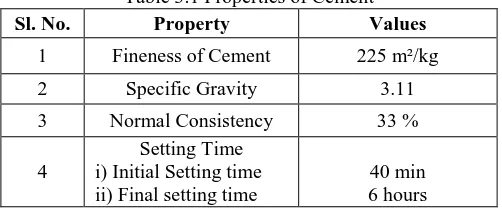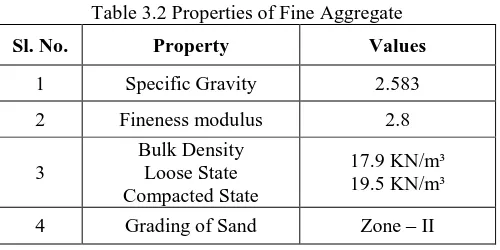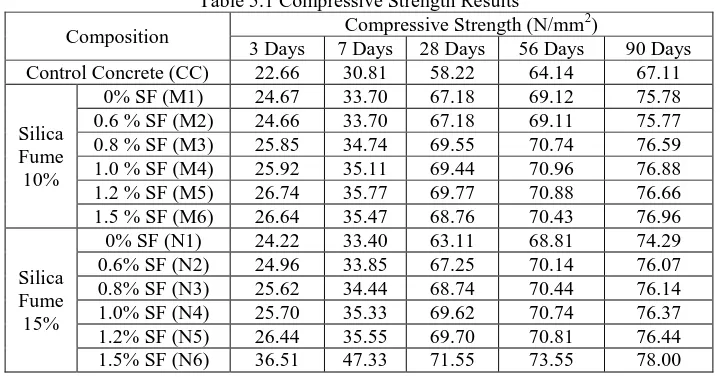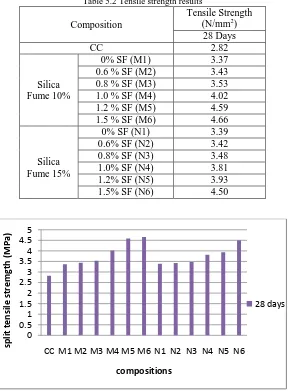An Experimental Study on Concrete by
Partial Replacement of Cement by Silica Fume
and With Steel Fibers
Bhavya
1, Raja Sekhar
2P.G. Student, Department of Civil Engineering, SVCET College, R.V.S.Nagar, Chittoor, India1 Associate Professor, Department of Civil Engineering, SVCET College, R.V.S.Nagar, Chittoor, India2
ABSTRACT: Silica fume is referred as microsilica or condensed silica fume, is another material that is used as an artificial pozzolanic admixture. It is a product resulting from readdition of high purity quartz with coal in an electric arc furnace in the manufacture of silicon or ferro silicon alloy. This paper shows the investigation on concrete due to the effect of silica fume with and without steel fibers on Ordinary Portland cement. In this study we used concrete mixes with Silica Fume of 10% , 15% with addition of steel hook fibers of diameter 0.6 mm Ø and length 30mm with a aspect ratio of 50, at various percentages as 0%, 0.6 %, 0.8%,1.0 %1.2% and 1.5 % by the volume of concrete on M50 grade of concrete. .
KEYWORDS:Steel Fibers (SF), Fiber-reinforced concrete (FRC), silica fume.
I. INTRODUCTION
Concrete based composites have long been utilized for common structures, for example, parkways, extensions and structures. However, startling decay of fortified or pre-focused on solid structures has prompted the change of solidness of cement. Customarily, the constituents of bond based composites incorporate cementitious material, water, total and/or admixtures.
Silica fume otherwise called miniaturized scale silica is a by-item Ad of the decrease of high-virtue quartz with coal in electric heaters in the generation of silicon and ferrosilicon combinations. Be-reason for its amazing fineness and high silica content, Silica Fume is an exceedingly powerful pozzolanic material. Silica Fume is utilized as a part of cement to enhance its properties like compressive quality, bond quality, and scraped area resistance; lessens penetrability; and in this manner aides in shielding strengthening steel from erosion.
1.1 Silica Fume
Silica fume is a by product of the industrial manufacture of ferrosilicon alloys and silicon metabolism high temperature electric arc furnaces. The use of silica fume helps in filling concrete pores resulting in improved im permeability of concrete, lesser moisture diffusion and increased strength attributed to the increased concrete density. Silica fume is a by product of the industrial manufacture of ferrosilicon alloys and silicon metabolism high temperature electric arc furnaces. The use of silica fume helps in filling concrete pores resulting in improved impermeability of concrete, lesser moisture diffusion and increased strength attributed to the increased concrete density.Silica fume can be used either as a densified or undensified powder, a slurry, as a combination at the concrete mixer, or part of a factory-blended cement.
Figure1.Sample of Silica Fume
The above figure shows the sample of Silica Fume used.
1.2 Steel Fibers
Steel fibers can improve the structural strength to reduce in the heavy steel reinforcement requirement. Freeze thaw resistance of the concrete is improved. Durability of the concrete is improved to reduce in the crack width.It has been shown in the research that fibers with low volume fractions (<1%), in fiber reinforced concrete, have an insignificant effect on both the compressive and tensile strength Improve structural strength. The beneficial influence of fibers in concrete depends on many factors such as type, shape, length and cross-section of fibers, strength and bond characteristics of fibers, fibers content, matrix strength, mix design and mixing of concrete.
Figure2.Sample of steel fibre The above figure shows the sample of Steel Fibres used.
II. RELATEDWORK
Milind V. Mohod carried out an experimental study on the performance of steel fiber reinforced concrete Cement concrete is the most extensively used construction material in the world. The reason for its extensive use is that it provides good workability and can be moulded to any shape.
Kavita S Kene et al. carried out anexperimental study on behavior of steel and glass fiber reinforced concrete composites fiber reinforced concrete (FRC) is a concrete in which small and discontinuous fibers are dispersed uniformly. The addition of these fibers into concrete mass can dramatically increase the compressive strength, tensile strength, flexural strength and impact strength of concrete.
spaced reinforcement, which can be provided in the form of randomly distributed fibers. Steel fiber is one of the most commonly used fibers. Short, discrete steel fibers provide discontinuous three-dimensional reinforcement that picks up load and transfer stresses at micro-crack level. This reinforcement provides tensile capacity and crack control to the concrete section prior to the establishment of visible macro cracks, thereby promoting ductility or toughness. The modulus of elasticity of concrete is a very important parameter reflecting the ability of concrete to deform elastically. In addition, in order to make full use of the compressive strength potential, the structures using high strength concrete tend to be slimmer and require a higher elastic modulus so as to maintain its stiffness. Therefore, knowledge of the modulus of elasticity of high strength concrete is very important in avoiding excessive deformation, providing satisfactory serviceability, and avoiding the most cost-effective designs. The present experimental study considers the effect of steel fibers on the modulus of elasticity of concrete.
Nikhil and Gadge1 carried out anexperimental study onmix design of fiber reinforced concrete (FRC) using slag & steel fiber concrete is probably the most extensively used construction material in the world. The main ingredient in the conventional concrete is Portland cement. The amount of cement production emits approximately equal amount of carbon dioxide into the atmosphere. Cement production is consuming significant amount of natural resources. That has brought pressures to reduce cement consumption by the use of supplementary materials. Availability of mineral admixtures marked opening of a new era for designing concrete mix of higher and higher strength
Shende1 et al. carried out an experimental study on steel fiber reinforced concrete for M-40 grade critical investigation for M-40 grade of concrete having mix proportion 1:1.43:3.04 with water cement ratio 0.35 to study the compressive strength, flexural strength, Split tensile strength of steel fiber reinforced concrete (SFRC) containing fibers of 0%, 1%, 2% and 3% volume fraction of hook tain. Steel fibers of 50, 60 and 67 aspect ratio were used. A result data obtained has been analyzed and compared with a control specimen (0% fiber). A relationship between aspect ratio vs. Compressive strength, aspect ratio vs. flexural strength, aspect ratio vs. Split tensile strength represented graphically. Result data clearly shows percentage increase in 28 days Compressive strength, Flexural strength and Split Tensile strength for M-40 Grade of Concrete.
Awchat and Kanhe carried out an experimental studies on polymer modified steel fiber reinforced recycled aggregate concrete waste concrete with a lower degree of contamination is a potential source for the production of aggregate for concrete mix. Recycled Course Aggregate (RCA) particles consist of substantial amount of relatively soft cement paste component also they are more porous and less resistant to mechanical actions. Since the era of using concrete for construction purposes, various researchers are continuously trying to improve the performance and various strengths of concrete by keeping options of economy in construction costs. One of the options is use of Polymer
Materials and their properties
a) Cement
The cement used for this project work is Zuari 53-grade ordinary portland cement. The various physical properties of cement used are tabulated in Table 3.1.
,
Table 3.1 Properties of Cement
Sl. No. Property Values
1 Fineness of Cement 225 m²/kg
2 Specific Gravity 3.11
3 Normal Consistency 33 %
4
Setting Time i) Initial Setting time ii) Final setting time
40 min 6 hours
b) Fine Aggregate:
Table 3.2 Properties of Fine Aggregate
Sl. No. Property Values
1 Specific Gravity 2.583
2 Fineness modulus 2.8
3
Bulk Density Loose State Compacted State
17.9 KN/m³ 19.5 KN/m³
4 Grading of Sand Zone – II
c) Coarse Aggregate:
The crushed granite aggregate of size passing through 20mm and retaining on 12.5mm standard sieve is used as coarse aggregate. The various properties of coarse aggregate are presented in Table 3.3.
Table 3.3 Properties of Coarse Aggregate
Sl. No. Properties Value
1 Specific Gravity 2.68
2 Bulk Density 14.13 KN/m³
3 Water Absorption 0.49%
4 Flakiness Index 13.19%
5 Elongation Index 20.49%
6 Crushing Value 14.72%
7 Impact Value 6.08%
8 Fineness Modulus 6.26
d) Properties of Steel fibers
Type : Hooked End
Nominal Dimensions
Diameter : 0.60 mm Length : 30 mm Aspect Ratio L/D 50 Tolerance for D/ L ± 10 %
As per ASTM
Yield Strength of Wire : > 1000 MPa Wire Mechanical Properties
Tensile strength of the wire : 1450 MPa Strain at failure : < 4 % Shape
The ending shapes of Hooked End Steel Fiber are very important to grant adhesion between fiber and concrete.
e) Water
III.MIX DESIGN
Based on these material properties, the Mix Design is prepared for Normal Concrete Mix IS: 10262-2009 method is used and the mix proportions and mix details are obtained as follows,
Table 4.1 Mix Proportion Water Cement Fine
aggregate
Coarse aggregate Proportion
by Weight 160kg 400kg 661.51kg 1220.19kg Proportion
by Ratio 0.4 1 1.65 3.05
Cube, cylinder and beam specimen are cast as per IS: 516-1978. In this process, once the wet concrete mixture is prepared of required standard the concrete is filled in cube moulds (150X150X150 mm) for compressive strength test. For Tensile strength the cylinders (300X150 mm) were casted. The specimen are removed after 24 hours and immersed in water tank for 3, 7, 28, 56 and 90 days. Then the specimen were removed from curing tank and tested immediately under Compression Testing Machine.
IV. EXPERIMENTAL RESULTS
a)
Compression testThe cube specimen was tested for compressive strength at the end of 3, 7, 28, 56 and 90days. The specimen was tested after the surface gets dried. The load was applied on the smooth sides without shock and increased continuously till the specimen failed. The mean compressive strength is calculated and tabulated in Table 5.1. Figure 3and 4 shows compressive strength of concrete at various curing periods for different proportions.
Table 5.1 Compressive Strength Results
Composition Compressive Strength (N/mm
2)
3 Days 7 Days 28 Days 56 Days 90 Days Control Concrete (CC) 22.66 30.81 58.22 64.14 67.11
Silica Fume 10%
0% SF (M1) 24.67 33.70 67.18 69.12 75.78
0.6 % SF (M2) 24.66 33.70 67.18 69.11 75.77
0.8 % SF (M3) 25.85 34.74 69.55 70.74 76.59
1.0 % SF (M4) 25.92 35.11 69.44 70.96 76.88
1.2 % SF (M5) 26.74 35.77 69.77 70.88 76.66
1.5 % SF (M6) 26.64 35.47 68.76 70.43 76.96
Silica Fume 15%
0% SF (N1) 24.22 33.40 63.11 68.81 74.29
0.6% SF (N2) 24.96 33.85 67.25 70.14 76.07
0.8% SF (N3) 25.62 34.44 68.74 70.44 76.14
1.0% SF (N4) 25.70 35.33 69.62 70.74 76.37
1.2% SF (N5) 26.44 35.55 69.70 70.81 76.44
Figure3. Bar chart comparison of compressive strength of concrete with Silica fume 10 % using steel fibers
Figure4. Bar chart comparison of compressive strength of concrete with Silica fume 15 % using steel fibers
b) Split tensile test
Split tensile test is also referred as “Brazilian Test”. Placing a cylindrical specimen horizontally between the loading surfaces of a compression-testing machine and the load is applied till the cylinder failed along the vertical diameter. The mean tensile strength is calculated and tabulated in Table 5.2
0 10 20 30 40 50 60 70 80 90
CC M1 M2 M3 M4 M5 M6
Co m press iv e st re ng th ( M P a ) Compositions 3 days 7 days 28 days 56 days 90 days 0 10 20 30 40 50 60 70 80 90
CC N1 N2 N3 N4 N5 N6
Table 5.2 Tensile strength results
Composition
Tensile Strength (N/mm2)
28 Days
CC 2.82
Silica Fume 10%
0% SF (M1) 3.37
0.6 % SF (M2) 3.43
0.8 % SF (M3) 3.53
1.0 % SF (M4) 4.02
1.2 % SF (M5) 4.59
1.5 % SF (M6) 4.66
Silica Fume 15%
0% SF (N1) 3.39
0.6% SF (N2) 3.42
0.8% SF (N3) 3.48
1.0% SF (N4) 3.81
1.2% SF (N5) 3.93
1.5% SF (N6) 4.50
Figure5. Comparison of Tensile strength of concrete with Silica fume 10% and 15 % using steel fibers
V. CONCLUSIONS
The compressive strength increases with the increase in silica fume compared with normal concrete. The values that are obtained at 3days,7 days, 28 days,56 days and 90 days of curing for 10% of silica fume replaced by PPC cement are 26.74,35.77,69.77,70.88,76.66.
When the cement is replaced with 10% silica fume and 1.2% steel fibers gives the optimum compressive strength, split tensile strength
At 10% silica fume and 1.2% steel fibers replacement to cement increases compressive strength up to 21.29% than conventional concrete in 28 days.
At 10% silica fume and 1.2% steel fibers replacement to cement increases split tensile strength up to 44.10% than conventional concrete in 28 days.
0 0.5 1 1.52 2.5 3 3.5 4 4.55
CC M1 M2 M3 M4 M5 M6 N1 N2 N3 N4 N5 N6
sp
lit
te
n
si
le
st
re
m
gth
(M
Pa)
compositions
On the basis of regression analysis of large number of experimental results, the statistical model showed in figures has been developed. The proposed model was found to have good accuracy in estimating the 28 days and 90 days Compressive strength with their inter relationship at 10% , 15% Silica Fume & 0%,0.6%,0.8%,1.0%,1.2%,1.5% Steel Fibers.
REFERENCES
1. P.R.M.I.T.&R., BadneraPerformance of Steel Fiber Reinforced Concrete.
2. Kavita S Kene Experimental Study on Behavior of Steel and Glass Fiber Reinforced Concrete Composites. 3. Misba Gul, Alsana BashirStudy of Modulus of Elasticity of Steel Fiber Reinforced Concrete.
4. Mr. Nikhil A. Gadge1, Mix Design of Fiber Reinforced Concrete (FRC) Using Slag & Steel Fiber, India 5. A.M. Shende1, A.M. Pande2 Experimental Study on Steel Fiber Reinforced Concrete for M-40 Grade ,India
6. Dr.G.D.Awchat1,Dr.N.M.Kanhe2 Experimental Studies on Polymer Modified Steel Fiber Reinforced Recycled Aggregate Concrete, Nagpur. 7. M.S. Shetty, (2004), Concrete technology, Chand S. and Co Ltd, India.
8. M.L. Gambhir, (2006), Concrete technology, Tata McGraw Hill Publishing Co. Ltd
9. IS 10262:2009 Code for Concrete Mix Proportion, Bureau of Indian Standards, New Delhi, India.



